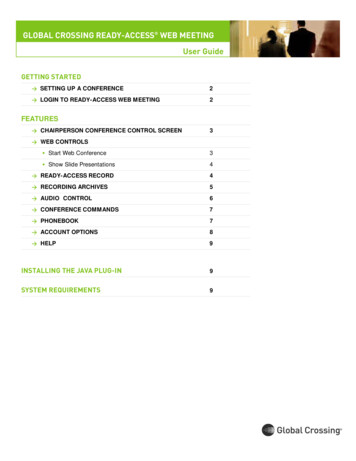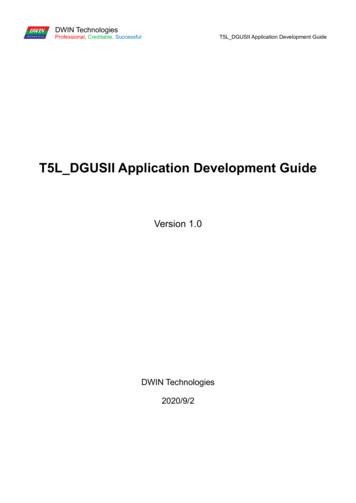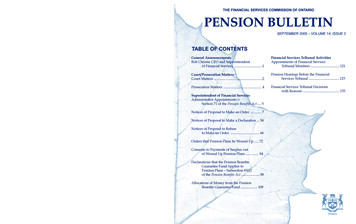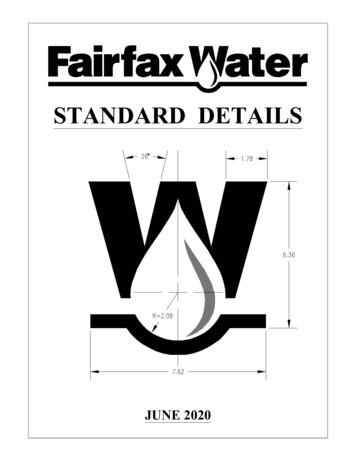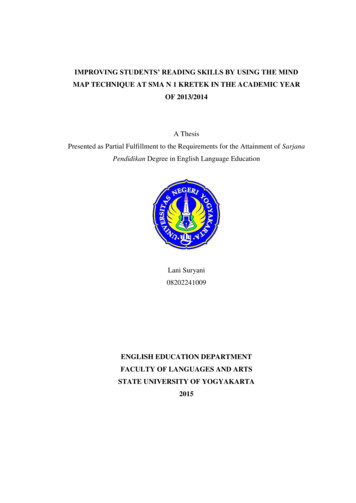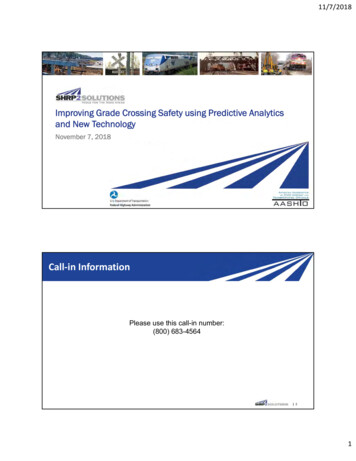
Transcription
11/7/2018Improving Grade Crossing Safety using Predictive Analyticsand New TechnologyNovember 7, 2018Call‐in InformationPlease use this call-in number:(800) 683-4564 21
11/7/2018Purpose of Today’s Webinar Provide an overview of predictive analytics recently adoptedby Union Pacific Railroad and new technology tested byNCDOT to improve grade crossing safety. Discuss and share information with State DOTs and Railroads. 3Agenda Welcome Safety Moment SHRP2 Program and R16 Information Improving Grade Crossing Safety using Predictive Analytics(UPRR) and New Technology (NCDOT) 42
11/7/2018Safety Moment What to do if your vehicle stalls or hangs up on the tracks:1. Get out immediately2. Move away3. Locate the emergency phone number4. Call for help 5SHRP2 Implementation:INNOVATE. IMPLEMENT. IMPROVE. 63
11/7/2018SHRP2 Implementation:INNOVATE. IMPLEMENT. IMPROVE. 7Railroad‐DOT MitigationStrategies (R16)Challenge Railroad-DOT interaction requires a thorough reviewof the safety, engineering, and the operationalimpacts of a roadway project during construction –since it will have lasting effects on the railroad fordecades thereafter. Rapid construction goals requirea new approach that eases the project agreementprocess for both industries.Solution Recommended practices, model agreements, andtraining materials to help resolve potential conflicts. 84
11/7/2018R16 Range of Activities Host Community of Interest providing forum for sharing of best practices andchallenges– annual face to face meeting in Q1– quarterly meetings by webinar Host SHRP2, R16 Web Page Provide SME Technical Assistance Host Webinars, topics selected by COI Host annual Peer Exchange in Q3 Produce Case Studies of most value to the COI Host state workshops to meet specific state DOT needs 9Innovation Library – R16 Webpage A library of agreements and other documents developed by state DOTs and railagencies. State and Railroad Agreements, Manuals, and Processes (R16) Organized by State/Railroad Organized by Topichttp://shrp2.transportation.org/Pages/R16 InnovationLibrary.aspx 105
11/7/2018A Few Housekeeping Details Tell us what you think. We want to hear from all of you on the call during theQuestion and Answer portion of the webinar. Do not use your computer’s audio; use the call-in number instead. State your name and organization before speaking. Download the agenda and PDF of this presentation from the Files section. 126
11/7/2018Radar-Based Highway Vehicle Detection Systemfor Four-Quadrant Gated CrossingsRichard E. Mullinax, PE, PTOE, CPMNovember 2018Disclaimer / LegalNCDOT does not endorse or recommend any commercial products, processes, or services.References to or appearance of any specific commercial products, processes, or services bytrade name, trademark, manufacturer, or otherwise does not constitute or imply itsendorsement, recommendation, or favoring by NCDOT.49 CFR 236(H) – Standards for Processor-Based Signals and Train Control Systems Promote safety of processor-based signal and train control systems, subsystems,and components that are safety critical 49 CFR 236.907 – product safety plan 49 CFR 236.913(j) – informational filing Informational filing / product safety plan must be submitted by the railroad147
11/7/2018Four-Quadrant Gates in North Carolina Exit gate descent is a pre‐timed offsetinterval Train detected, entry gates descendfirst Exit gates descend varies from site‐to‐site (typically 7 to 12 seconds delaybetween entry gate and exit gatedescent)Proven to reduce crossing violations by 84%SO WHAT IS THE ISSUE?151234ViolationsContinue168
11/7/2018Dynamic Gate OperationsWhat Does This Mean? Entry gate and exit gate could descend simultaneously. But would require a vehicle detection system. If a vehicle is detected within the crossing, exit gate descent canbe delayed to allow the highway vehicle a clear path off thecrossingMUTCD A mode of operation where the exit gate operation is based onthe presence of vehicles within the minimum track clearancedistance If used, highway vehicle intrusion detection devices that are partof a system that incorporates processing logic to detect thepresence of vehicles within the minimum track clearancedistance should be installed to control exit gate operations17Radar-Based Highway Vehicle Detection Out-of-street detection Impact to / from track and surface work will beminimal Pavement surface quality will not impact reliability Roadway pavement shifting will not cause afailure Provides redundancy Two radar units continuously check inputs forcorrespondence between the units Minimal impact to the railroad Should not negatively impact railroad operations Minimum “in crossing” installation labor Continuous and event triggered recording capabilities189
11/7/2018Vehicle Detection System19System Communications2010
11/7/2018Video Cameras Continuous real-time feed Alerts emailed with images and clips for atypical vehicle movements Train activated clip Begins 30 seconds prior to train entering crossing Ends 30 seconds after train exits crossingDetection mple: Vehicle detected in Zone 2, and a train on the approach circuit21Radar-Based Highway Vehicle Detection System FHWA grants ( 757,800)Island Radar- A Wavetronix Company – SmartSensor-Rail RadarNCDOT owned and maintained per agreement with Norfolk SouthernInstalled at 7 locations along the H-line between Salisbury and Durham, NC 3 locations activated March 2014 4 locations activated February – April 2016 AREMA compliant Except for a brief period, gates continue to operate pretimed during theevaluation and continue to operate pretimed today11
11/7/2018Radar-Based Highway Vehicle Detection System23Image Captures2412
11/7/2018Image Captures25Dual Matrix Radar Evaluation by NCSU – ITRE (Institute for Transportation Research and Education)Evaluation period - 22 Mar 2014 through 31 Oct 20167,900 gate activations with 99.81% reliability15 false negative (vehicle missed) 4 due to size of detection zone – zone modified and no further misses 11 due to high vehicle speeds through the crossing – not high priority for detection 55 false positives (vehicle not present) Due to train being present momentarily in detection zone after it cleared the crossing –not high priority Due to radar system reacting faster than the crossing system System continues in operation today ITRE continuous monitoring Still reliable Weather extremes (snow, ice, humidity, heat, and hurricanes)2613
11/7/2018Conclusions 1 in 5 activations had a violating highway vehicle(pretimed) Defined as entering a crossing after the startof entry gate descend. System performed at least at the same level ofeffectiveness as inductive detection loops System appears robust and able to withstandenvironmental extremes Island Radar VDR24 Vehicle Detection Radar(powered by Wavetronix) accepted by FRA (PSPapproved for BNSF, Union Pacific, and CanadianPacific) Future action – Implementation of dynamic gateoperations pending submittal and approval of aNorfolk Southern modified PSP.27A special thanks to:Mr. Tom Hilleary, Island Radar – A Wavetronix CompanyMr. Daniel Findley, PhD, PE – NCSU – ITREMr. Daniel Coble, EI – NCSU - ITREContact: remullinax@ncdot.gov2814
11/7/2018CrossingModel &DiagnosticPaul D. RathgeberDirector of Industry &Public Projects29Crossings Are Safe for Prudent Motorists Drivers, road authorities, and railroads allhave a part to play in crossing safety When a crossing is maintained tomaintenance standards, the stage has beenset for a reasonably prudent driver totraverse the crossing safely. Vast majority of incidents are driver behavior3015
11/7/2018Grade Crossing IncidentsSharp AnnualReductionGoal: Toward Zero CrossingIncidentsRecent 2015201620172018YTD31UPRR Crossing Assessment ProgramRegression Model OverviewThe Zero-Inflated Regressive model does notpredict which crossings SHALL have Frequentor Severe IncidentsThe model does not rank crossingsThe model DOES objectively Establish statistically relevant factors Establish predicted frequency and severity Groups related crossingsThe Model correlatespast incidents withcrossing characteristicsIncidents are theDependant Variable Self adjusts Can incorporate new types of data3216
11/7/2018Process OverviewDataModelProbabilityClusterIncident frequency& severity andcrossing attributesSignificant predictors& magnitude of effectsPredictedfrequency /severity foreach crossingBased onpredictedfrequency &severityTier(1, 2 or 3) Clusters are based on probability of incident (frequency & severity), not actualoccurrence––Tier 1 & 2 crossings may have no incidents in historyRisk is determined based on incidents at other crossings with similar attributes Probability is determined by factors in the model––Some factors may not be in model due to correlation with othersOr may not be significant after accounting for other factors33Data Tested in Analysis (candidate variables)Frequency Model Significant FactorsSeverity Model Significant Factors3417
11/7/2018Leveraging Safety at Crossings30000100%Tier 1Tier 3Tier 21870%34Crossings56782015 % of Predicted Incidents50% of all average daily train counts changed more than 10% after improved data source utilizedPredict 30% of incidents at 5.6% of total crossings35Diagnostics are the Next Step Acquire PE agreement The diagnostic team evaluates the crossingas to its opportunities and judgmentalconsensus as to the recommendedimprovements. Three areas:– Traffic Operations (vehicular and train)– Traffic Control Devices (vehicular and train)– Administration (financial responsibility) The diagnostic team should study allavailable data and inspect the crossingand its surroundings with the objective ofdetermining the conditions that affect safetyand traffic operations.3618
11/7/2018What data do we use? Documents––––––––––– Call Center Data with NarrativesTimetableSignal front sheetFRA and UPRR Inventory & Accident HistoryTrain countsAerialRight of Way Dimension MapModel Output with Statistical FactorsSignal Remedy TicketsInterconnected Crossing Inspection or Testing ReportsStarter Sketch and ChecklistField review and observations––––––––––53.1.1 –Railroad inspectionSite distancesTraffic patternsPedestrian patternsSurface conditionIntersection configurationApproachesStorage distanceTraffic signals / preemptionNew Developments37Using Model DataWhat does the data tell you? Identify Key Driver Statistics – summary tableIncident TypeCrossing Accident ‐ Injured PartyEnvironmental IncidentFatality ‐ TrespasserFire Related IncidentRough CrossingTrain/Vehicle Accident Non‐crossing ‐ Property DamageVehicle on TrackGrand TotalCount of Incident Type1121118153819
11/7/2018Using Model DataWhat does the data tell you? Create quarterly or monthly date chart Look for trends–4 events in 2013Vehicle on Track32Vehicle on Track1039Using Model DataWhat does the data tell you? Create Time (rounded) chart Look for trends–5 events occurred between 8:00 11:00 PMVehicle on Track432Vehicle on Track1012:00 AM4:00 AM6:00 AM8:00 PM10:00 PM4020
11/7/2018Using Model DataWhat does the data tell you? Read all narrativesDOT751199PRoadGILMAN STREETMP7.06Date Occurred Time Occurred Incident Type9/7/20157:45 PM Vehicle on Track11/21/20135:55 AM Vehicle on TrackSubdivisionMARTINEZ SUBDOTRoadMP751199PGILMAN STREETDateOccurredTimeOccurredIncident TypeSubdivisionMARTINEZ7.0 SU6 BIncident Narrative 1Cervantes, Berkeley Police, advised a vehicle on the tracks at the 4th Street and GillmanAvenue crossing which is Mile Post 7.06 of the Martinez Subdivision in Berkeley, CA. TheLegal Red Flare Advisement was issued. Kevin Crim, Train Dispatcher, was notified andadvised train traffic was stopped. Eric Kelly, Special Agent, was notified. UPDATE: At 07:56PM, Anderson, Berkeley Police, advised the vehicle was a blue four door Kia Rio withCalifornia license plate 9851EDP, officers were on scene, and a tow service was en route .Kevin Crim, Train Dispatcher, was updated. UPDATE: At 08:02 PM, Josh Whiting, CorridorManager, requested and received updated incident information. Anderson, Berkeley Police,was contacted and advised the the vehicle was on a siding track, not obstructing the mainline, and requested reduced train speeds. Mr. Whiting was updated. UPDATE: At 08:21 PM,Anderson, Berkeley Police, advised the vehicle was removed from the tracks and personnelwere clear of the scene. Anderson stated the vehicle came to rest on the tracks due todriver error. Josh Whiting, Corridor Manager, was updated. Kevin Crim, Train Dispatcher,was updated. Eric Kelly, Special Agent, was updated.John Cooper, Train Dispatcher, reported the crew of Train YOA43 20, Lead LocomotiveUP6452, observed a vehicle high centered on Mainline Two at Mile Post 7.25 of theMartinez Subdivision. Mr. Cooper stated a vehicle description was not available. Operator523, Berkeley Police Department, was notified and advised officers and a tow service wouldbe dispatched. Jeffery Fikes, Senior Special Agent, was notified. UPDATE: At 06:40 AM,Calvan, Berkeley Police Department, advised the vehicle was clear of the crossing. JohnThiessen, Train Dispatcher, was updated.Incident Narrative 1Cervantes, Berkeley Police, advised a vehicle on the tracks at the 4th Street and Gillman Avenue crossing which isMile Post 7.06 of the Martinez Subdivision in Berkeley, CA. The Legal Red9/7/2015Flare7:45Advisementwas issued. KevinPM Vehicle on TrackCrim, Train Dispatcher, was notified and advised train traffic was stopped. Eric Kelly, Special Agent, was notified.UPDATE: At 07:56 PM, Anderson, Berkeley Police, advised the vehicle was a blue four door Kia Rio with CaliforniaAM Vehicle on Tracklicense plate 9851EDP, officers were on scene, and a tow service was en11/21/2013route5:55. KevinCrim, Train Dispatcher, wasupdated. UPDATE: At 08:02 PM, Josh Whiting, Corridor Manager, requested and received updated incidentinformation. Anderson, Berkeley Police, was contacted and advised the the vehicle was on a siding track, notobstructing the main line, and requested reduced train speeds. Mr. Whiting was updated. UPDATE: At 08:21 PM,Anderson, Berkeley Police, advised the vehicle was removed from the tracks and personnel were clear of thescene. Anderson stated the vehicle came to rest on the tracks due to driver error. Josh Whiting, Corridor Manager,was updated. Kevin Crim, Train Dispatcher, was updated. Eric Kelly, Special Agent, was updated.John Cooper, Train Dispatcher, reported the crew of Train YOA43 20, Lead Locomotive UP6452, observed a vehiclehigh centered on Mainline Two at Mile Post 7.25 of the Martinez Subdivision. Mr. Cooper stated a vehicledescription was not available. Operator 523, Berkeley Police Department, was notified and advised officers and atow service would be dispatched. Jeffery Fikes, Senior Special Agent, was notified. UPDATE: At 06:40 AM, Calvan,Berkeley Police Department, advised the vehicle was clear of the crossing. John Thiessen, Train Dispatcher, wasupdated.41Crossing AnalysisProblem-Solving Drilldown1. Use Data to Develop a Problem Statement2. Research and Field Observationsi.Interview local forces, Law Enforcement, etc.ii.Drive all approachesiii.Observe crossing behavior from an inconspicuous locationiv.Walk the approachesProblem-solvingfor targetedrecommendations3. “5 - Whys”4. Observation Statement(s)5. Recommendations address observation statements4221
11/7/2018One Example of Advanced Reviews:Overview of UPRR in Colorado 1,503 Miles of Track 658 Public At Grade Road Crossings UP, BNSF, ATK, RTDC, GRNWUp to 55 Trains Per Day1-8 Tracks1-6 Lanes of trafficMax Timetable Speeds of up to 70 MPH3002442502332001509110044502440112543Colorado Crossing Examples1 Public Tier 1Havana Street, Denver20 Public Tier 2’sWashington St, 51st Ave, & York St, DenverChambers & Airport Rd, AuroraMain St, LucerneRobinson Ave, FlorenceRoyer St & Las Animas St, Colorado Springs5th St, Castle Rock4422
11/7/2018Recommendation Categories3.533In Transition:Current conditions impact normal traffic flow32.5222Enforcement:Joint event with local Law Enforcement21.511110.501No Recommendations:Crossing Observed Functioning as IntendedPreviously Mitigated:Completed Project work with Partners45Colorado Specific Recommendations Add Do Not Stop On Tracks R8-8 Refresh Edge Line Markings Refresh Median Line Markings Add Stop Line – RR Markings Add Vehicle Detection Relocate signage for improved drivervisibility/earlier warning Crossing in Transition Target Enforcement Propose Intersection Reconfiguration No Recommendations-PreviouslyMitigated No Recommendations-Functioning asIntended4623
11/7/2018What does success look like?East Tabor, Fairfield, California, Tier 1 Public Martinez Sub11,000 cars per dayBEFORE ENHANCEMENTS: 25 Vehicles on TrackObserved improper queuing & traversal of the crossingData told us motorists were turning between or ontotracks Recommended adding edge lines, changing location ofright turn arrow pavement markings, and replacingdelineators AFTER ENHANCEMENTS– Completed in Dec 2015:– 1-18-16, 1 Vehicle stalled and high centered– 1-4-18, 1 Vehicle drove off crossing and became stuck NO FURTHER INCIDENTS AND NO COLLISIONS47Summary Predict rather than React Future Options: Proximity Model vs Priority Index vs ZeroInflated Regression State by State vs System Use available data from both the Road Authority and the Railroads Go where the data takes us Analyze before holding a diagnostic Hold a Comprehensive Diagnostic Focus recommendations based on data, observations, & local color Federal Agencies, Road Authorities & Railroads must be partners4824
11/7/2018Paul D. Rathgeberpaulrathgeber@up.comQuestions?49Questions & Discussion25
11/7/2018For More InformationProduct Leads:Katie HulbertFHWA Sponsorkathleen.hulbert@dot.govKate KurganAASHTO Co-Product Leadkkurgan@aashto.orgAdditional O SHRP2 http://shrp2.transportation.orgWebsite:R16 16 RailroadDOTMitigationStrategies.aspxPam HuttonAASHTO Co-Product Leadphutton@aashto.orgHal LindseyR16 Project Managerhal.lindsey@jacobs.com 5126
11/7/2018 1 Improving Grade Crossing Safety using Predictive Analytics and New Technology November 7


